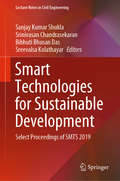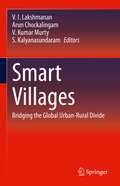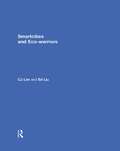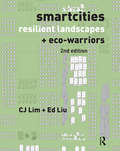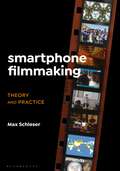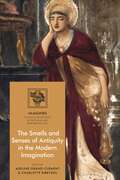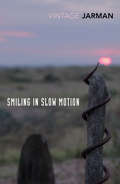- Table View
- List View
Smart Technologies for Sustainable Development: Select Proceedings of SMTS 2019 (Lecture Notes in Civil Engineering #78)
by Sanjay Kumar Shukla Srinivasan Chandrasekaran Bibhuti Bhusan Das Sreevalsa KolathayarThis book presents select papers from the International Conference on Smart Materials and Techniques for Sustainable Development (SMTS) 2019. The contents focus on a wide range of methods and techniques related to sustainable development fields like smart structures and materials, innovation in water resource development, optical fiber communication, green construction materials, optimization and innovation in structural design, structural dynamics and earthquake engineering, structural health monitoring, nanomaterials, nanotechnology and sensors, smart biomaterials and medical devices, materials for energy conversion and storage devices, and IoT in sustainable development. This book aims to provide up-to-date and authoritative knowledge from both industrial and academic worlds, sharing best practice in the field of smart materials analysis. The contents of this book will be beneficial to students, researchers, and professionals working in the field of smart materials and sustainable development.
Smart Technologies, Systems and Applications: Second International Conference, SmartTech-IC 2021, Quito, Ecuador, December 1–3, 2021, Revised Selected Papers (Communications in Computer and Information Science #1532)
by Fabián R. Narváez Julio Proaño Paulina Morillo Diego Vallejo Daniel González Montoya Gloria M. DíazThis book constitutes refereed proceedings of the Second International Conference on Smart Technologies, Systems and Applications, held in Quito, Ecuador, in December 2021. Due to the COVID-19 pandemic the conference was held in a hybrid format. The 29 full papers along with 1 short paper presented were carefully reviewed and selected from 104 submissions. The papers of this volume are organized in topical sections on smart technologies; smart systems; smart trends and applications.
Smart Technology: First International Conference, MTYMEX 2017, Monterrey, Mexico, May 24-26, 2017, Proceedings (Lecture Notes of the Institute for Computer Sciences, Social Informatics and Telecommunications Engineering #213)
by Francisco Torres Guerrero Jorge Lozoya-Santos Eduardo Gonzalez Mendivil Leticia Neira-Tovar Pablo G. Ramírez Flores Jorge Martin-GutierrezThis book constitutes the refereed proceedings of the First International Conference on Smart Technology, MTYMEX 2017, held in Monterrey, Mexico, in May 2017. The 19 full papers were selected from 30 submissions and cover smart technologies for education, health, robotics, internet of things, virtual augmented and mixed reality technologies, artificial intelligence, gaming, software development, and digital arts.
Smart Textiles for Designers: Inventing the Future of Fabric
by Rebeccah Pailes-FriedmanWe are on the cusp of a revolution, where the intersection of technology, the human body and everyday objects will become completely seamless. Smart textiles are a key part of this revolution.Smart Textiles for Designers introduces the different qualities and properties that can be embedded in, integrated with, and applied to fabrics and looks at the different contexts in which these smart textiles can be used, from healthcare to haute couture, firefighting to sportswear. A survey of specific fabrics grouped by properties provides a core reference section and a palette for the designer to work from. The book also examines five different design approaches and features interviews with leading designers and design teams, showing their processes and working methods.The first book to look at this exciting and quickly developing area of technology through the eyes of a designer, this is both a core reference work and an inspirational guide for students and professionals alike.
Smart Villages: Bridging the Global Urban-Rural Divide
by V. I. Lakshmanan Arun Chockalingam V. Kumar Murty S. KalyanasundaramThis book brings together technical expertise, best practices, case studies and ground-level application of the ideas for empowering the rural population of the world to live economically prosperous, environmentally sustainable, and socially progressive lives, on par or comparable with the quality of life enjoyed by the global urban population. The idea of Smart Villages takes on greater urgency in light of the investments made in this millennium on “Smart Cities”, taking advantage of the technological advances, particularly in digital connectivity. These investments have and will continue to expand the urban-rural divide, unless similar investments are made in the villages as well. The book provides a much-needed guide for a holistic development of a Smart Village, by defining the need, developing the framework, and describing the delivery, complete with successful case studies. Contributors to the book, from Canada, USA, Africa and India bring years of academic, industry and governmental experience, including organization of several Smart Village conferences. The knowledge base in the book will be of great value to anyone interested in or active in rural planning, including governmental and non-governmental organizations, industrial solution providers, public healthcare professionals, public policy professionals and students, as well as rural communities around the world. Consolidates all the aspects of creating/developing a Smart Village;Delivers an effective tool-kit for practitioners in the area of Smart Villages;Provides a policy-based framework for the development of an ideal Smart Village;Illustrates, through case studies, the fulfillment of key requirements of a Smart Village;Brings together experts from around the world to share their vision of a Smart Village;Highlights the importance of balancing development with social/gender equity and cultural traditions.
Smartcities and Eco-Warriors: The Ecological Landscapes For Urban Resilience
by Cj Lim Ed LiuModern methods of agriculture have led to cities growing out of control and reducing the available agricultural land, threatening the sustainability of our food system. The previous mutually sustaining relationships of animals, humans and the land have been lost with the progress of industry. The Smartcity – an ecological symbiosis between nature, society and the built form – is the innovative response to contemporary problems from one of the world’s leading urban design and architectural thinkers. Addressing the problems of unchecked city growth, the idea of the Smartcity questions whether we could begin to live once again from first principles, focusing in on the inhabitants of the city. The holistic construct of the Smartcity is developed through a series of international case studies, some commissioned by government organisations, others speculative and polemic. Reframing the way people think about urban green space and the evolution of cities, CJ Lim and Ed Liu explore how the reintegration of agriculture in urban environments can cultivate new spatial practices and social cohesion in addition to food for our tables. Representing an emerging architectural voice in matters of environmental and social sustainability, Smartcities and Eco-warriors is a long overdue treatment of the subject from a designer’s perspective, and is essential reading for practitioners and students in the fields of architecture, urban planning, environmental engineering, landscape design, agriculture and sociology. An inspiration to government agencies and NGOs dealing with climate change, it also resonates with anyone concerned about cities, energy conservation and the future of food
Smartcities and Eco-Warriors
by Cj Lim Ed LiuModern methods of agriculture have led to cities growing out of control and reducing the available agricultural land, threatening the sustainability of our food system. The previous mutually sustaining relationships of animals, humans and the land have been lost with the progress of industry. The Smartcity – an ecological symbiosis between nature, society and the built form – is the innovative response to contemporary problems from one of the world’s leading urban design and architectural thinkers. Addressing the problems of unchecked city growth, the idea of the Smartcity questions whether we could begin to live once again from first principles, focusing in on the inhabitants of the city. The holistic construct of the Smartcity is developed through a series of international case studies, some commissioned by government organisations, others speculative and polemic. Reframing the way people think about urban green space and the evolution of cities, CJ Lim and Ed Liu explore how the reintegration of agriculture in urban environments can cultivate new spatial practices and social cohesion in addition to food for our tables. Representing an emerging architectural voice in matters of environmental and social sustainability, Smartcities and Eco-warriors is a long overdue treatment of the subject from a designer’s perspective, and is essential reading for practitioners and students in the fields of architecture, urban planning, environmental engineering, landscape design, agriculture and sociology. An inspiration to government agencies and NGOs dealing with climate change, it also resonates with anyone concerned about cities, energy conservation and the future of food
Smartcities, Resilient Landscapes and Eco-Warriors: The Ecological Landscapes For Urban Resilience
by CJ Lim Ed LiuFollowing on from the success of the first edition, Smartcities + Eco-Warriors (2010), this book is the latest innovative response on urban resilience from one of the world’s leading urban design and architectural thinkers. An ecological symbiosis between nature, society and the built form, the Smartcity cultivates new spatial practices and creates diverse forms of resilient landscapes including and beyond urban agriculture. The notion of the Smartcity is developed through a series of international case studies, some commissioned by government organisations, others speculative and polemic. This second edition has nine new case studies, and additional ecological sustainability studies covering sensitivity, design criteria, and assessments for ecological construction plans. The book concludes with two new essays on the romance of trees and the empowering nature of resilient landscapes. Smartcities, Resilient Landscapes + Eco-warriors represents a crucial voice in the discourse of climate change and the potential opportunities to improve the ecological function of existing habitats or create new landscapes which are considered beneficial to local ecology and resilience. It is indispensable reading for practitioners and students in the fields of landscape, urban design, architecture and environmental engineering. An inspiration to government agencies and NGOs dealing with sustainability, this work also resonates with anyone concerned about cities, landscapes, food and water security, and energy conservation.
Smartcities, Resilient Landscapes and Eco-Warriors: The Ecological Landscapes For Urban Resilience
by CJ Lim Ed LiuFollowing on from the success of the first edition, Smartcities + Eco-Warriors (2010), this book is the latest innovative response on urban resilience from one of the world’s leading urban design and architectural thinkers. An ecological symbiosis between nature, society and the built form, the Smartcity cultivates new spatial practices and creates diverse forms of resilient landscapes including and beyond urban agriculture. The notion of the Smartcity is developed through a series of international case studies, some commissioned by government organisations, others speculative and polemic. This second edition has nine new case studies, and additional ecological sustainability studies covering sensitivity, design criteria, and assessments for ecological construction plans. The book concludes with two new essays on the romance of trees and the empowering nature of resilient landscapes. Smartcities, Resilient Landscapes + Eco-warriors represents a crucial voice in the discourse of climate change and the potential opportunities to improve the ecological function of existing habitats or create new landscapes which are considered beneficial to local ecology and resilience. It is indispensable reading for practitioners and students in the fields of landscape, urban design, architecture and environmental engineering. An inspiration to government agencies and NGOs dealing with sustainability, this work also resonates with anyone concerned about cities, landscapes, food and water security, and energy conservation.
SmartDraw For Dummies
by Daniel G. Hoffmann Doug LoweDiagrams, organizational charts, flowcharts, even floor plans — they’re all types of business graphics. Only one tool does ’em all: SmartDraw. SmartDraw For Dummies shows you how this business graphics software helps you make boring presentations exciting and how to create graphics that can help you sell, manage, inform, motivate, and more. You’ll learn how to set up the program, navigate its somewhat unique interface, and work with SmartDraw’s thousands of templates. You don’t need artistic talent, just this handy guide and the extended, fully functional trial version of SmartDraw that’s on the bonus CD! Use SmartDraw templates to create org charts, flowcharts, express charts, mind maps, Live Maps, and more Dress up your graphics with color, effects, and design themes Learn to integrate your graphics into Microsoft Office applications and animate graphics for cool PowerPoint presentations Explore SmartDraw diagrams for Web pages and e-mail newsletters Import SmartDraw graphics into Word and Excel documents Take advantage of extra software and additional templates, sample drawings and flowcharts, image editing tools, maps, and flyers on the CD You’ll also find graphics guidelines to help you create more effective charts and presentations, plus tips on using color and images to your advantage. Written by a Microsoft PowerPoint MVP and a SmartDraw vice president, SmartDraw For Dummies helps you banish boring charts forever! Note: CD-ROM/DVD and other supplementary materials are not included as part of eBook file.
SmartDraw For Dummies
by Daniel G. Hoffmann Doug LoweDiagrams, organizational charts, flowcharts, even floor plans — they’re all types of business graphics. Only one tool does ’em all: SmartDraw. SmartDraw For Dummies shows you how this business graphics software helps you make boring presentations exciting and how to create graphics that can help you sell, manage, inform, motivate, and more. You’ll learn how to set up the program, navigate its somewhat unique interface, and work with SmartDraw’s thousands of templates. You don’t need artistic talent, just this handy guide and the extended, fully functional trial version of SmartDraw that’s on the bonus CD! Use SmartDraw templates to create org charts, flowcharts, express charts, mind maps, Live Maps, and more Dress up your graphics with color, effects, and design themes Learn to integrate your graphics into Microsoft Office applications and animate graphics for cool PowerPoint presentations Explore SmartDraw diagrams for Web pages and e-mail newsletters Import SmartDraw graphics into Word and Excel documents Take advantage of extra software and additional templates, sample drawings and flowcharts, image editing tools, maps, and flyers on the CD You’ll also find graphics guidelines to help you create more effective charts and presentations, plus tips on using color and images to your advantage. Written by a Microsoft PowerPoint MVP and a SmartDraw vice president, SmartDraw For Dummies helps you banish boring charts forever! Note: CD-ROM/DVD and other supplementary materials are not included as part of eBook file.
SmartKom: Foundations of Multimodal Dialogue Systems (Cognitive Technologies)
by Wolfgang WahlsterWith contributions by leading scientists in the field, this book gives the first comprehensive overview of the results of the seminal SmartKom project – one of the most advanced multimodal dialogue systems worldwide.
Smartphone Filmmaking: Theory and Practice
by Max SchleserMobile, smartphone and pocket filmmaking is a global phenomenon with distinctive festivals, filmmakers and creatives that are defining an original film form. Smartphone Filmmaking: Theory and Practice explores diverse approaches towards smartphone filmmaking and interviews an overview of the international smartphone filmmaking community. Interviews with smartphone filmmakers, entrepreneurs, creative technologists, storytellers, educators and smartphone film festival directors provide a source of inspiration and insights for professionals, emerging filmmakers and rookies who would like to join this creative community. While not every story might be appropriate to be realized with a mobile device or smartphone, if working with communities, capturing locations or working in the domain of personal or first-person filmmaking, the smartphone or mobile device should be considered as the camera of choice. The mobile specificity is expressed through accessibility, mobility and its intimate and immediate qualities. These smartphone filmmaking-specific characteristics and personal forms of crafting experiences contribute to a formation of new storytelling approaches. Stylistic developments of vertical video and collaborative processes in smartphone filmmaking are evolving into hybrid formats that resonate in other film forms.This book not only develops a framework for the analysis of smartphone filmmaking but also reviews contemporary scholarship and directions within the creative arts and the creative industries. Smartphone Filmmaking: Theory and Practice initiates a conversation on current trends and discusses its impact on adjacent disciplines and recent developments in emerging media and screen production, such as Mobile XR (extended reality).
Smartphone Filmmaking: Theory and Practice
by Max SchleserMobile, smartphone and pocket filmmaking is a global phenomenon with distinctive festivals, filmmakers and creatives that are defining an original film form. Smartphone Filmmaking: Theory and Practice explores diverse approaches towards smartphone filmmaking and interviews an overview of the international smartphone filmmaking community. Interviews with smartphone filmmakers, entrepreneurs, creative technologists, storytellers, educators and smartphone film festival directors provide a source of inspiration and insights for professionals, emerging filmmakers and rookies who would like to join this creative community. While not every story might be appropriate to be realized with a mobile device or smartphone, if working with communities, capturing locations or working in the domain of personal or first-person filmmaking, the smartphone or mobile device should be considered as the camera of choice. The mobile specificity is expressed through accessibility, mobility and its intimate and immediate qualities. These smartphone filmmaking-specific characteristics and personal forms of crafting experiences contribute to a formation of new storytelling approaches. Stylistic developments of vertical video and collaborative processes in smartphone filmmaking are evolving into hybrid formats that resonate in other film forms.This book not only develops a framework for the analysis of smartphone filmmaking but also reviews contemporary scholarship and directions within the creative arts and the creative industries. Smartphone Filmmaking: Theory and Practice initiates a conversation on current trends and discusses its impact on adjacent disciplines and recent developments in emerging media and screen production, such as Mobile XR (extended reality).
SmartWatch Design Fundamentals: WatchFace Design for Samsung Galaxy SmartWatches
by Wallace JacksonGain concepts central to smartwatch design, editing and animation correction using the popular open source Galaxy Watch Designer software package. This visual guide builds upon the essential concepts of smartwatch design, decoration, digital imaging, animation, function integration, and visual effects, and gets more advanced as chapters progress, covering which digital new media file formats (JPEG, PNG, GIF, etc.) are best for use with smartwatch design.Smart Watch Design Fundamentals also covers key factors in the data footprint optimization work process, designing and optimizing animation assets, and why these optimizations are important. Additionally, the book covers other advanced topics such as how to provide free smartwatch faces for the first few days on the smartwatch store, and how to post watchface designs for sale in the store.What You'll Learn:Create a smartwatch design and visual effects pipelineGain knowledge of the concepts behind smartwatch designWork with resolution, aspect ratio, animation, and color depthUse smartwatch design components such as ticks, numerals, feature markers, dates, etc. Optimizing digital image asset data footprint to create small smartwatch design file sizesWho This Book Is For:This book is primarily for smart watch and fashion designers.
Smashing It: Working Class Artists on Life, Art and Making It Happen
by Sabrina MahfouzWorking-class artists are hugely under-represented in the arts industries, facing extra challenges from unpaid work to prejudice, though they make up a third of the British population. How can we break this cycle of inequality?Smashing It celebrates the achievements of working-class artists in Britain, from the global takeover of Grime musicians to the literary powerhouses pushing representative narratives, also showcasing their works. Offering guidance and inspiration, leading musicians, playwrights, visual artists, filmmakers and writers share how they overcame obstacles, from the financial to the philosophical, to make it in the arts.An essential read, Smashing It will empower those who will be a part of tomorrow’s bigger picture.
The Smells and Senses of Antiquity in the Modern Imagination (IMAGINES – Classical Receptions in the Visual and Performing Arts)
by Adeline Grand-Clément and Charlotte RibeyrolThis volume tackles the role of smell, under-explored in relation to the other senses, in the modern rejection, reappraisal and idealisation of antiquity. Among the senses olfaction in particular has often been overlooked in classical reception studies due to its evanescent nature, which makes this sense difficult to apprehend in its past instantiations. And yet, the smells associated with a given figure or social group convey a rich imagery which in turn connotes specific values: perfumes, scents and foul odours both reflect and mould the ways in which a society thinks or acts. Smells also help to distinguish between male and female, citizens and strangers, and play an important role during rituals. The Smells and Senses of Antiquity in the Modern Imagination focuses on the representation of ancient smells - both enticing and repugnant - in the visual and performative arts from the late 18th century up to the 21st century. The individual contributions explore painting, sculpture, literature and film, but also theatrical performance, museum exhibitions, advertising, television series, historical reenactment and graphic novels, which have all played a part in reshaping modern audiences' perceptions and experiences of the antique.
The Smells and Senses of Antiquity in the Modern Imagination (IMAGINES – Classical Receptions in the Visual and Performing Arts)
This volume tackles the role of smell, under-explored in relation to the other senses, in the modern rejection, reappraisal and idealisation of antiquity. Among the senses olfaction in particular has often been overlooked in classical reception studies due to its evanescent nature, which makes this sense difficult to apprehend in its past instantiations. And yet, the smells associated with a given figure or social group convey a rich imagery which in turn connotes specific values: perfumes, scents and foul odours both reflect and mould the ways in which a society thinks or acts. Smells also help to distinguish between male and female, citizens and strangers, and play an important role during rituals. The Smells and Senses of Antiquity in the Modern Imagination focuses on the representation of ancient smells - both enticing and repugnant - in the visual and performative arts from the late 18th century up to the 21st century. The individual contributions explore painting, sculpture, literature and film, but also theatrical performance, museum exhibitions, advertising, television series, historical reenactment and graphic novels, which have all played a part in reshaping modern audiences' perceptions and experiences of the antique.
SMIL 3.0: Flexible Multimedia for Web, Mobile Devices and Daisy Talking Books (X.media.publishing)
by Dick C.A. Bulterman Lloyd W. RutledgeSMIL 3.0: Multimedia for the Web, Mobile Devices and Daisy Talking Books is a revised introduction to — and resource guide for — the W3C SMIL language. It covers all aspects of the SMIL specification and covers all of SMIL’s implem- tation profiles, from the desktop through the world of mobile SMIL devices. Based on the first version of the book, which covered SMIL 2.0, this edition has been updated with information from the past two releases of the SMIL l- guage. We have benefitted from comments and suggestions from many readers of the first edition, and have produced what we feel is the most comprehensive guide to SMIL available anywhere. Motivation for this Book While we were working on various phases of the SMIL recommendations, it became clear to us that the richness of the SMIL language could easily ov- whelm many Web authors and designers. In the 500+ pages that the SYMM working group needed to describe the 30+ SMIL elements and the 150+ SMIL attributes, there was not much room for background information or extensive examples. The focus of the specification was on implementation aspects of the SMIL language, not on the rationale or the potential uses of SMIL’s declarative power.
Smiling in Slow Motion: Diaries, 1991-1994
by Derek Jarman'For days now I have tried to start this diary, but the clatter of my existence has warned me off; the first mark on the page eludes me...'Derek Jarman's Smiling in Slow Motion concludes the journey started in Modern Nature, these previously unpublished journals stretch from May 1991 until a fortnight before his death in February 1994. Part diary, part observation, part memoir, Jarman writes with his familiar honesty, wry humour and acuity. Friends, collaborators and enemies are catalogued as he races through his last year painting, film-making, gardening, and annoying his targets through his involvement in radical politics.Writing from his Charing Cross Road flat, on his visits to international film festivals, his world famous garden at Dungeness in Kent, and finally from his bed in St Bartholomew's Hospital, Jarman illuminates an era which seems more ephemeral and out-of-grasp with each passing day. Smiling in Slow Motion is not a document of illness, regret and resignation, but one of endeavour, remembrance and love.
Smithsonian Stories: Chronicle of a Golden Age, 1964-1984
by Wilton S. DillonWhy is the Smithsonian more than the "Nation's Attic?" Or more than a museum complex? As Wilton S. Dillon shows, the Smithsonian came to be the institution we know today under the twenty-year leadership of "Sun King" S. Dillon Ripley.Ripley aspired to reinvent the Smithsonian as a great university with museums. Although little understood by the public at large, it began as a basic research center. The Smithsonian remains a key contributor to the world of higher learning and functions diplomatically as the ministry of culture for the United States. Dillon provides backstage insights into Ripley's quest for the wholeness of knowledge. He describes how he inspired its role as a "theater of ideas as well as artifacts." Under his tutelage, the National Mall became a playground for world intelligentsia, an "intellectual free trade zone" in the shadow of the nation's political capital.Dillon reminds us that interdisciplinary, international Smithsonian symposia foreshadowed twenty-first-century issues and trends. His descriptions of the educational rewards of balancing tradition with the avant-garde are inspiring. As Dillon reminds us, Ripley's twenty-year reign may well have helped spark the waning embers of the Enlightenment.
Smithsonian Stories: Chronicle of a Golden Age, 1964-1984
by Wilton S. DillonWhy is the Smithsonian more than the "Nation's Attic?" Or more than a museum complex? As Wilton S. Dillon shows, the Smithsonian came to be the institution we know today under the twenty-year leadership of "Sun King" S. Dillon Ripley.Ripley aspired to reinvent the Smithsonian as a great university with museums. Although little understood by the public at large, it began as a basic research center. The Smithsonian remains a key contributor to the world of higher learning and functions diplomatically as the ministry of culture for the United States. Dillon provides backstage insights into Ripley's quest for the wholeness of knowledge. He describes how he inspired its role as a "theater of ideas as well as artifacts." Under his tutelage, the National Mall became a playground for world intelligentsia, an "intellectual free trade zone" in the shadow of the nation's political capital.Dillon reminds us that interdisciplinary, international Smithsonian symposia foreshadowed twenty-first-century issues and trends. His descriptions of the educational rewards of balancing tradition with the avant-garde are inspiring. As Dillon reminds us, Ripley's twenty-year reign may well have helped spark the waning embers of the Enlightenment.
Smoke
by John BergerJohn Berger, art critic, novelist and long-time smoker, joins forces again with Turkish illustrator Selcuk Demirel. This charming pictorial essay reflects on the cultural implications of smoking and suggests, through a series of brilliantly inventive illustrations, that society's attitudes to smoking are paradoxical.
Smoke and Mirrors: The Yenidze Cigarette Factory, Dresden (Space and Place #22)
by David NielsenThe Yenidze Cigarette Factory of 1909 was constructed as an industrial, architectural object that advertised Dresden as a center for the tobacco trade. Born from a unique client-architect relationship between Hugo Zietz and Martin Hammitzsch, the factory’s importance to modernism has been understated. Smoke and Mirrors uncovers the history of the factory’s planning, design, and construction, and for the first time, apart from the building’s historical narrative, positions this addition to Dresden’s skyline within the formative histories of the modern movement.
Smoke and Mirrors: The Yenidze Cigarette Factory, Dresden (Space and Place #22)
by David NielsenThe Yenidze Cigarette Factory of 1909 was constructed as an industrial, architectural object that advertised Dresden as a center for the tobacco trade. Born from a unique client-architect relationship between Hugo Zietz and Martin Hammitzsch, the factory’s importance to modernism has been understated. Smoke and Mirrors uncovers the history of the factory’s planning, design, and construction, and for the first time, apart from the building’s historical narrative, positions this addition to Dresden’s skyline within the formative histories of the modern movement.
